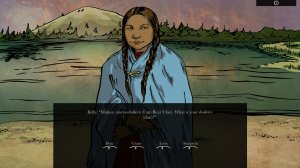Lessons Learned in Teaching Native American History
A white teacher shares resources and things she’s learned: Be humble, find the gaps in your knowledge, and listen to Native voices.
Your content has been saved!
Go to My Saved Content.As a white middle school teacher in Oregon attempting to integrate the Native American story in my history lessons, I’ve found that one of the most common misconceptions my students have about American history is thinking that Oregon was empty prior to the Oregon Trail.
When I think about my students and their visions of covered wagons journeying into a wilderness with “lots of bears and no people” as one of my students said, I can’t help but wonder about how we as educators are teaching (or not teaching) our students about the rich and vibrant history and cultures of Native Americans.
I’ve spoken about this with many educators, and I’ve come to realize the lack of training and resources that teachers have for how to teach Native American history and culture. Think about these statistics from 2011–12: 27 states did not mention any individual Native Americans in K–12 standards, and 87 percent of state history standards didn’t cover Native American history after 1900. But there are over 5 million Native Americans belonging to 573 nations throughout the United States today.
In many schools, students are learning that Native American tribes no longer exist, or they gain the impression that Native Americans continue to live in teepees—misconceptions and biases that are damaging to modern Native communities.

What Teachers Can Do
First, we need to humble ourselves and admit that there are gaps in our own knowledge of history. We need to strive to educate ourselves and fill in those gaps with culturally sensitive information, by opening ourselves to multiple perspectives and taking time to truly listen. I’ve included a list of resources below that teachers can use to get started.
One of my gaps: I’ve been teaching Native American history for years and only recently learned that Oregon had its own version of the Trail of Tears—a tragic story I learned from an educator with the Grand Ronde Tribe. I’ve found speaking to members of a nearby tribe to be invaluable. Use a map to locate a local tribe and then Google the tribe’s name. Many tribes have a website with an education tab, and many also have an educator on staff who can provide resources and answer questions from teachers.
Next, we can add a land acknowledgement early on in the school year. Every school in the United States is located on Native Americans’ ancestral land. Making a land acknowledgement is taking time to recognize the tribes that once lived where our schools now sit. Information about land acknowledgements—including a guide for writing one—is available online.
We should be sure that students recognize that Native American history is American history. It does not need to be taught separately—it should be taught along with the broader events and themes and questions posed in American history to show a multitude of viewpoints. In American history, for example, we look to dates like 1776 as essential to understanding our history, but do we think Native Americans view those dates the same way? This is an important question we can ask ourselves and our students.
Next, as we’re teaching about Native American history and culture, we need to make sure that we prioritize the contemporary. Native American cultures are alive, breathing, and beautiful, but 87 percent of state history standards don’t mention that. It’s essential for all students—especially those in classrooms where they do not have Native American peers—to understand that Native Americans are not gone. As teachers, we need to emphasize modern issues that impact Native American tribes and the modern successes of tribes.
Resources for Teaching Native American History
While culturally sensitive resources for teaching Native American history and culture can be hard to find, they do exist. Consider exploring the following resources and integrating them into your curriculum.
- Native 360 is a resource for teachers and students created by the Smithsonian National Museum of the American Indian. It includes in-depth lesson plans, primary sources, video interviews, and interactive programs. All of these materials are created in cooperation with tribes to tell the real history the way Native Americans want it to be heard.
- Pulling Together: A Guide for Curriculum Developers is a free, open-source curriculum guide with lesson plans and ideas. It is designed for high school and college students but can be easily adapted to suit younger grades as well.
- Highlight free Native American news sources like Indian Country Today and Indigenizing the News in your classroom. Many of us use current events on a regular basis, and teaching with balanced perspectives is very valuable.
- Invasion of America is a time-lapse map that allows viewers to explore the growth of the United States in terms of the seizure of Native lands—valuable context for the study of U.S. history in the 1700s and 1800s.
- Native America Calling is a call-in radio program that focuses on issues specific to Native communities. The broadcasts include the perspectives of experts and callers who share their experiences. The program’s website includes an archive of episodes.
- Students love the traditional Oregon Trail computer game, so try having them play the game When Rivers Were Trails (available for Windows, Android, and macOS). Funded by the Indian Land Tenure Foundation, it’s fun and interactive.
[Editor’s note: The list of resources on this page has been updated on October 3, 2019.]
